Illustrative examples
Nora-Corina Jacob, a doctoral scholar in promoting creativity and innovation, identifies five investigative skills as the foundation for innovative ideas: questioning, observing, experimenting, networking, and associating.
Questioning
Questioning is a superb approach to engage students with a subject, as it ignites their inherent motivation. A spirit of curiosity is kindled, and students become enthusiastic and entertained. Rather than delivering facts, teachers can pose open-ended questions, or reverse a question: Instead of "How do you deliver an excellent presentation?" ask "What are the ways to deliver an exceptionally poor one?" This kind of questioning encourages creativity, brings joy, and fuels curiosity.
Another technique is Question Storming, in which 50 questions about a specific topic are collected, without concern for the answers. For instance, when studying Goethe's Faust, one could ask: "Why do you think Goethe wrote this work? Why did he choose a devil rather than an angel as Faust's companion? How would the story change if Faust were a woman?" Afterward, the questions are gathered, sorted, and prioritized. Furthermore, by generating a multitude of "what if" questions around a topic and then discussing them, students can engage in broader exploration and creative thought.
For students to retain the outcome of their collaborative efforts, it's crucial to rephrase the shared conclusion once or twice. Furthermore, exploring exceptions to established rules and patterns is another effective method for promoting inquiry-based learning. It's also beneficial for students to develop their own problem statements around a topic.
Observing
Observation can be practiced everywhere and in countless ways: on the bus, at the playground, or in the home kitchen. In these settings, students can ponder possible improvements to the activities they carry out. Paul Collard cites a project in Lithuania where students visited a train station, a market, and a church, jotting down the sounds they heard. It was challenging to translate sounds into words – but that's part of the process. Excursions into nature or within the city provide students with new stimuli, allowing them to gather materials and broaden their perspectives.
For example, during a class trip to a sensory garden, students can experience different textures underfoot, promoting sensory awareness. Similarly, a school garden offers varied sensory experiences such as sight, touch, smell, taste, and sound, fostering creativity (see the article "Urban Gardening - A Trend Based on Tradition").
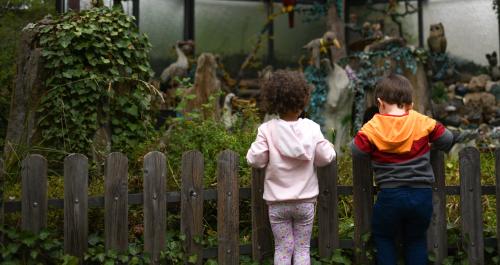
Students can also learn through observation at museums, cooking classes, or driving schools, and then apply their observations to their own inquiries.
Experimenting
Experimentation isn't limited to physics and chemistry classes; it can be integrated into any subject. In language arts, students could write a poem, an advertisement, or a clear instruction manual, or participate in a reading. The important part is allowing for divergent approaches in the creation process.
Similarly, breaking boundaries in other subjects can also stimulate creativity: for instance, visiting a dam in a geography class, examining a burial mound in history, dissecting an everyday object in physics, or trying different aiming techniques in physical education. Competitions can also motivate students to engage their cognitive abilities.
Networking
Traditional school models often restrict students to their grade levels. This should be reconsidered where feasible. Students from different grades can gain unique perspectives from their age disparities, especially when expressing diverse views in ethics class. Cross-grade work groups serve a similar purpose. In the absence of competitive pressure, an atmosphere conducive to creative learning can be fostered.
After-school programs or school festivals provide further networking opportunities. Students can also engage with external contacts during school trips to companies or when experts from various fields are invited to the school for discussions.
Studio Schools
In the United Kingdom, Studio Schools focus less on theoretical knowledge and more on practical skills. This novel concept is designed to prepare 14 to 19-year-olds for the real-world job market. The school operates year-round, 9 a.m. to 5 p.m., and provides students with plenty of hands-on experience directly within companies. Paid internships are integrated into the curriculum, often leading to employment within the same company after graduation. Critics, however, express concerns about early specialization.
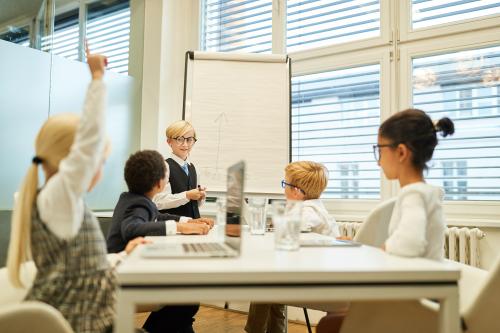
Networking in so-called democratic schools is so extensive that all teaching occurs across grade levels (see also "Actually, I Really Like School"). Nevertheless, even within traditional grade structures, students can learn significantly from each other, as they often come from diverse cultural backgrounds, speak different home languages, belong to various religions, have unique hobbies, and come from different social classes.
Associating
In his address to university graduates, Steve Jobs shared his experience of attending a calligraphy class in college. Despite not completing his studies at the time, he later utilized his calligraphy knowledge to design innovative fonts for the Mac, leading to its enormous success. This ability to associate unrelated things can be nurtured from an early age in the classroom.
This way of linking things can also be practiced at a very early stage in class: Two students each think of a word (for example, "vacuum cleaner" and "fried potatoes"). The class tries to link the two words. Games available on the market can also be helpful in practicing linking: there is one that contains playing cards with terms that hardly anyone knows. Players try to come up with a plausible definition for the word. There are TV shows that work in a similar way.
Defixation
Mathieu Cassotti, a developmental psychology professor at the University of Paris Descartes, conducted workshops with 10-year-olds to boost their creativity. The focus was on defixing methods, aiming to counteract our inherent automatic thought patterns that often narrow our perspectives. When students do fall into repetitive thought patterns, teachers should indicate that their ideas are circling around the same concept and encourage them to consider different approaches.
For example, when Cassotti asked the children to retell the tale of Little Red Riding Hood differently, the children initially struggled. Cassotti gave the children the task of telling the fairy tale of Little Red Riding Hood differently. At first, the children were stumped. He helped them along by suggesting that Little Red Riding Hood could become Little Green Riding Hood. What he observed was that this redirection of the thought process immediately led to a new fixation: The children wanted to turn Little Red Riding Hood into Little Blue, Little Yellow and Little Purple Riding Hood. He then suggested alternatives, like what would Little Red Riding Hood be without a cap? Could new characters appear in the story? These prompts gradually inspired the students to be more inventive.
Similarly, in another exercise, in which the question was: imagine we drop an egg from a height of 10 meters, while it must not break - what is the best way to do this? At first, the obvious solutions were suggested: equip the egg with a paraglider; place a pool of water at the bottom to serve as a landing surface; wrap the egg in absorbent cotton. The more unusual Cassotti's ideas became, the more creative the children became: you could freeze the egg beforehand ... A bird catches the egg in flight ... The young course participants had managed to break out of the pattern and were able to think much more creatively at the end of the workshop than before. The lecturer also observed that a development in one area of creativity (painting, writing, making music, etc.) also had an impact on other areas.
Confronting problems
Brice Sicart, a fine arts specialist at the Académie de Créteil, proposes introducing paradoxes or constraints in the classroom, thus presenting students with a problem to solve. This approach enhances their creativity. For instance, asking students to imagine a giant walking through the classroom and then represent this in their own way, cultivates creative problem-solving skills. Some children will knock over chairs in the room, others will paint footprints on the floor, still others will draw a giant face and stick it behind the glass, others may move the floor tiles. Each child has their own ideas and learns from the ideas of others.
Utilizing Different Senses
Nora-Corina Jacob shares an instance of a teacher who had students create art inspired by music. Other variations of sensory learning can also be implemented: students can sculpt a figure from clay based on a scent, compose a musical piece inspired by a color, or describe the taste of their favorite dish.
Fun in math class
Agata Ludwa, a mathematician who introduces elementary students to math, advocates that math can and should be fun. Although math is a precise science, the approach can be creative. After all, it's by no means always the case that there has to be only one solution. Ludwa gives an example: the children find a line in their textbook made up of the following numbers: 4, 18, 27, 1, 21, 24, 0, 25, 6, 30. Above this, the question: "This is the result if you take a certain number times 7." The result in this task: 21, because the 21 is a multiple of 7. But the answer can also be 0, because 7 times 0 results in 0. Thus, there are two solutions here.
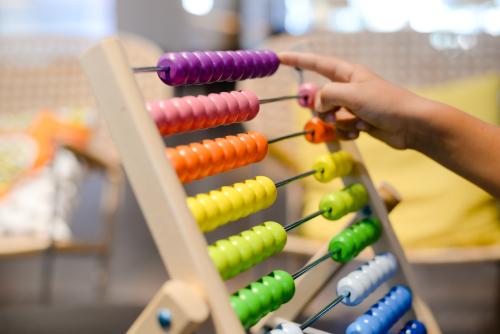
Also arithmetic problems within a special context can be fun. For instance, consider this problem: Paul and Felix are 22 years old combined. How old were they together two years ago? When will they be 30 years old together?
Overall, it's not challenging to make math lessons exciting and diverse. Ludwa offers many more possibilities in her video: Math problems in rhyme form, riddles, or even in the form of a detective story.
Mandatory Course: Creativity
Tanja Gabriele Baudson proposes introducing a mandatory course, "Creativity," in schools, focusing mainly on fostering the implementation of creative ideas. Here, students can choose their areas of interest to explore their creativity. The scope of activity need not be limited to a single domain; instead, students are encouraged to exhibit creativity across different subjects. The curriculum is a blend of independent and project-based learning. In this context, teachers play a vital role in directing projects in a meaningful manner and ensuring their relevance to the students' real-life experiences. When students can apply the outcomes of their projects in real life, their motivation levels surpass those driven solely by the pursuit of good grades. Indeed, a student who takes pride in a self-initiated product during independent learning time will eagerly look forward to new projects.
Assessment: Yay or Nay?
It's a challenging question to answer, but let's try: Since artists always create something outside the conventional system, assessing their works seems impractical. Jordan Peterson advocates this viewpoint. Conversely, Brice Sicart posits that learning cannot occur without assessment, as it aids skill development. Evaluations are integral to the professional realm too, with projects continually assessed by managers or customers. Hence, evaluation should be viewed not as punitive, but as a stepping-stone towards honing one's skills.
The Downside of Evaluation in Relationships
In personal relationships, evaluations are not only contentious but also often discouraged by psychologists. This perspective is reflected in the nonviolent communication model proposed by Marshall B. Rosenberg. Remember when you shared your project with someone, they quickly added their advice, and you felt demotivated afterwards? Precisely. Therefore, unless directly asked for, hold off on evaluations and suggestions. The responsibility for individual life choices rests with the individual. Those who heed their intuition make the best decisions for themselves.
So, how should a piece of art be evaluated? Should the creator solely evaluate it, as suggested by Tanja Gabriele Baudson? After all, the artist is the one who decides when the text needs no more revisions or when the painting requires no more brush strokes. Should a knowledgeable committee be consulted to achieve consensus? Is it feasible to arrive at a collective judgement? In a school setting, at least, the teacher shouldn't be the sole authority over a student's work.
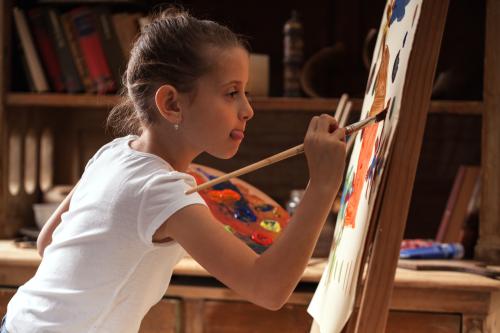
In his essay on assessing the quality of ideas, Boris Forthmann outlines several dimensions for evaluating creative school performance. These criteria include idea fluency (the sheer number of ideas), originality (how unique a solution is), flexibility (the diversity of problem-solving approaches), elaboration (the detailed visualization of a solution), cleverness (appropriateness and inventiveness of the idea), and surprise (the unexpectedness of the idea).
Defining Art
Claus Martin provides a simple answer: "Art is no more and no less than a good idea and its successful realization through craftsmanship." The key lies in recognizing a good idea and its artistic potential – and then transform it into a tangible artwork. Without a solid idea, a true piece of art cannot exist. Even though portrait painters in busy city squares may exhibit remarkable craftsmanship, their works bear no comparison to those of Salvador Dalí or Claude Monet. In the past, masters often entrusted the creation of their pieces to assistants, reserving the final touches and initial composition idea for themselves. However, even the best ideas are futile if not translated into reality by the means of skilled craftsmanship.
Is the blend of an idea and its execution what constitutes a piece of art? Not exactly. Martin continues: an ignored artwork is meaningless. It gains significance when an observer views the painting, a reader peruses the novel, or a listener appreciates the music. The recipient completes the artwork by attributing meaning to it. The pleasure derived from the induced images and thoughts in their mind represents the best-case scenario.
Is There Good and Bad Art?
According to Claus Martin, absolutely. The composer notes that the reluctance to critique art stems from the era of the Third Reich. He perceives an undue reverence for creativity in Germany, akin to the notion that creative writing is unteachable. This apprehension is exclusive to the arts. A math teacher would never compliment a student's calculations if both the result and the process were flawed.
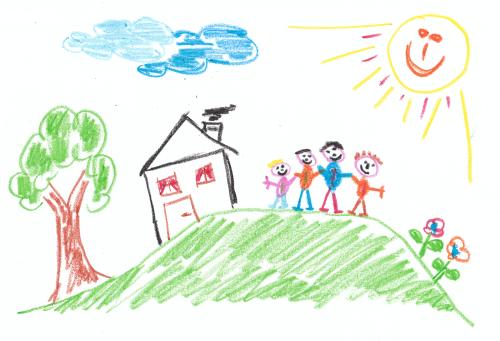
Yes, there is successful art and unsuccessful art, and it's not merely a matter of personal taste. Forming a critically informed opinion demands effort.
The Art of Evaluation
Delivering an informed judgement is not instinctive but a learned skill, akin to writing or learning a new language. It is a long-term process. Judgement should serve to assess not only others' works but one's own as well. The ideal foundation for this is the study of renowned masterpieces.
When evaluating art (not only limited to fine arts), Claus Martin suggests considering three temporal dimensions: the era in which the work was created, the period depicted in the artwork, and the reader's, viewer's, or listener's time. A piece of art might affect a viewer in ways the artist never intended due to the viewer's individual life experiences. Thus, art appreciation and evaluation are partially subjective processes.
An art judgement comprises both objective and subjective criteria. Objectively, craftsmanship can be assessed. Schools typically categorize paintings into styles like Impressionism or Expressionism, and literary works into periods like Sturm und Drang or Romanticism. Students decode works — a process akin to following a cooking recipe. However, they remain mere observers rather than active recipients, which limits their learning experience.
While schools should equip students with the tools to critique artworks, they should also teach that art judgement is largely subjective. Differing critiques can coexist validly, and they are not absolute truths but subjective perspectives influenced by their temporal context. Traditional objective knowledge impartation in schools must be complemented with subjective aspects.
Moreover, teachers should motivate students to form independent judgements and have the self-assurance to decide their preferences, distinguishing between personal taste and objective quality criteria.
School of the Future
What might a future school look like? Tanja Gabriele Baudson and Julia Sophie Haager offer specific ideas: In such a school, creativity isn't just one skill among many, but an essential component of personal development, thus integral to the curriculum. Creative skill acquisition is considered a standard of education. Teachers, trained in this field, engage their creativity and act as mentors and stimulators within the classroom.
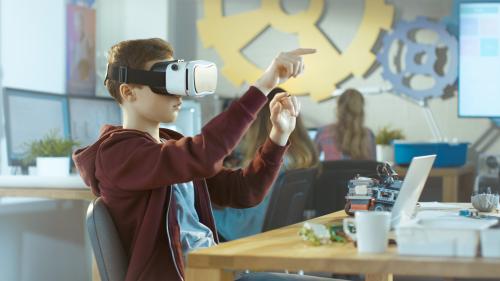
Every student receives individualized support. As a result, not all students achieve the same level of knowledge or education. The uniqueness of each student is respected. Not every child needs to be innately creative; some may be less so and prefer it that way. Such differences are accepted. This approach prevents the onset of 'creative stress'; promoting creativity doesn't deteriorate into forced creativity. It's vital to recognize that even students with less pronounced creative potential can contribute to the community.
Given the individualized support, the future school doesn't segregate by age groups. Children of all ages learn from one another, forming a creative field. Everyone develops at their own pace and progresses through school according to their timeline, potentially resulting in some students completing their education earlier than others, or reaching higher competencies. At this school, students do not graduate.
In this future school, referred to as "learning houses" by Baudson and Haager, children spend most of their week autonomously learning, following flexible schedules. Students and teachers maintain core times at the learning house but also enjoy some flexibility. There are no set vacation periods; instead, students and teachers schedule their vacations within certain parameters. Traditional vacations are replaced by project weeks, during which students work on real projects, complete internships at companies, and network.
Designed like a campus, the future school offers students the freedom to choose their learning environment—inside or outside. They discover an engaging learning environment equipped with versatile educational tools that inspire them daily. Uniform, dull classrooms become a relic of the past. Instead, the children themselves design the rooms.
In these learning houses, flat hierarchies prevail, and the joy of learning permeates. The houses resemble creative talent workshops more than today's conventional schools.
Students learn by listening to lectures and others' ideas, researching, investigating, or creating. The curriculum offers an appropriate level of challenge without being overwhelming. Pure knowledge transfer or rote memorization isn't the focus. Instead, students acquire knowledge, understand its context, develop things within a context, and learn skills and behavioral patterns (observed in their teachers).
Each student's learning profile is compiled in a digital learning diary, continuously updated. This diary accompanies the children in their daily tasks, solved either on paper or digitally, ensuring they don't feel perpetually monitored. Every three months, teachers and students review the student's knowledge level and discuss future learning objectives.
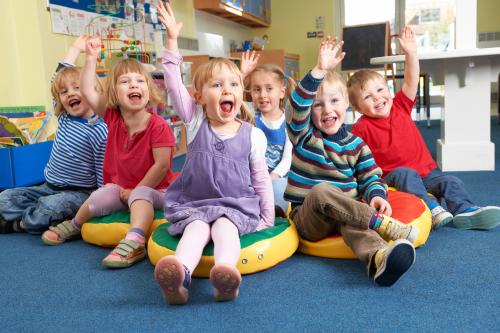
Questions that arise during learning are posted in designated forums, benefiting all. For specific questions, children can reach out to teachers directly, not to get all the answers, but to receive guidance towards finding answers themselves.
Ideally, learning houses are globally networked, ensuring everyone benefits from the created learning materials. Students perfect their foreign language skills and gain insights from peers worldwide, working on similar problems. They have the opportunity to collaborate on projects.
To think differently, students must learn to act differently. The learning houses provide this opportunity, which, hopefully, won't remain a mere vision.
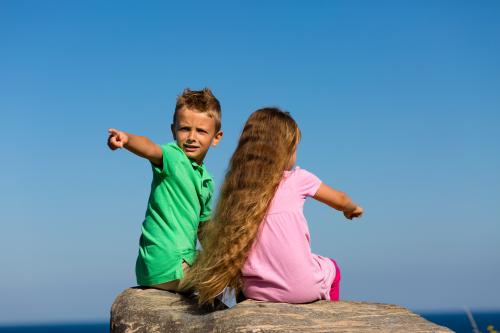
All kinds of contradictions
As you might have noticed, contradictions appear throughout this text: A fact is explained and later perhaps entirely contradicted. This is intentional: we wanted to depict as many facets of creativity as possible, and contradictions are inherent to creativity. They make up not only our science and art but our entire lives. We're certain a new perspective is just around the next corner!
Why This Comprehensive Article on Creativity?
Creativity, as we've seen, isn't only a vital part of our world; childhood is almost defined by it. It significantly contributes to healthy development, is immensely important in learning, and shapes your children's future lives.
Children are close to our hearts: our own, yours, the neighbors'. We wish for all of them to freely develop their creativity. Therefore, we aim to provide you with tools to foster more creativity in your children's lives—and your own.
But there's more: for over forty years, we've been embodying this creativity by inventing a modular toy that never existed before. We continually develop it, drawing inspiration from your experiences, pushing into new areas (refer to our QUADRO Nature section for more details).
With the most important point yet to mention, QUADRO is a profoundly creative toy. Don't believe it? Explore our model database. You'll find over 400 different models, from climbing frames to the Ultra Climbing Pyramid Extreme, pirate ships to pool bars. We indeed are creative. Now it's your turn, you and your kids: Invent something unique, something fitting for your home, your yard. Something no one else has. Let your imagination run wild and invent something we haven't even thought of yet.

Sources
- Julia Sophie Haager, Tanja Gabriele Baudson (Hrsg.) Kreativität in der Schule finden, fördern, leben. Psychologie in Bildung und Erziehung: Vom Wissen zum Handeln. Springer Fachmedien, 2019
- Austin Kleon. Steal Like an Artist: 10 Things Nobody Told You About Being Creative. Workman Publishing, 2012.
- What is a Studio School?
- Lehrplan Kunst. Hessisches Kultusministerium 2010
- Zitate berühmter Personen. Albert Einstein
- Tim Harford. A powerful way to unleash your natural creativity. TED, 07.02.2019
- Ethan Hawke. Give yourself permission to be creative. TED, 11.08.2020
- Adam Grant. The surprising habits of original thinkers. TED, 26.04.2016
- Plötzlich macht es klick! Wie kommen wir auf gute Ideen? | Bas Kast | SWR Tele-Akademie, 24.08.2016
- Joseph Gordon-Levitt. How craving attention makes you less creative. TED, 12.09.2019
- Lectures: Exploring the Psychology of Creativity. National Gallery of Canada, 27.04.20017
- The 6 Habits of Exceptionally Creative People, 26.07.2020
- V. O. Complète. Une vie consacrée à la créativité et à l’enfance. Arno et André Stern, 03.12.2019
- Prof. Dr. Manfred Spitzer Keynote: „Ist Kreativität lernbar?“, 15.10.2012
- Paul Collard. What does Creative Education look like in Lithuania? 3.08.2012
- Paul Collard: What is a creative education and why is it important?. Scottish Learning Festival 2012
- Jak rozwijać kreatywność dzieci w przedszkolu? 23.11.2021
- 3 clés pour aider nos enfants à développer leur créativité. 09.11.2015
- Kreatywna matematyka. Jak podążać za pomysłowością dzieci?, 19.05.2020
- Jak być kreatywnym – Wojciech Eichelberger (Strefa Psyche SWPS), 11.12.2014
- Are children really more creative than adults? | Elisabeth McClure | TEDxAarhus, 08.01.2019
- Creativity: The science behind the madness, 03.07.2020
- Ugo Cavenaghi. La créativité, ça s’enseigne ! TEDxUmontreal, 04.12.2018
- Kids Team UW. University of Washington, 4.10.2017
- Cyril de Sousa Cardoso. Et si la créativité était juste une habitude ? TEDxVaugirardRoad 2013
- The Psychology of Creativity, 04.11.2020
- Giovanni Corazza. Creative thinking - how to get out of the box and generate ideas. TEDxRoma. 11.03.2014
- #3 La créativité. Papier Crayon, 05.09.2018
- One of the Greatest Speeches Ever | Steve Jobs. Motivation Ark
- Ken Robinson sagt: Schule erstickt die Kreativität
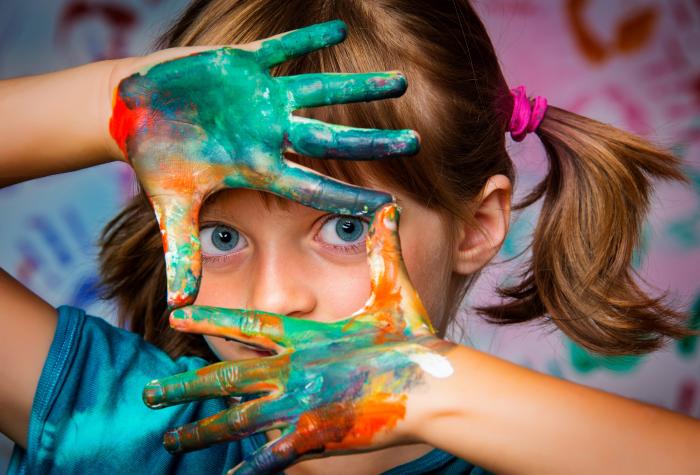
Komentari